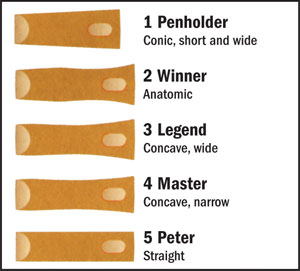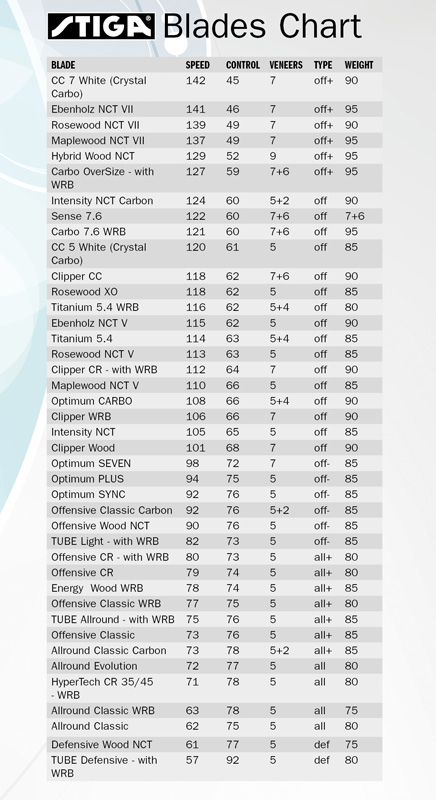General Blade Information
We show you the value of speed and spin to indicate the nature of the blade or rubber. The control factor is only a guide; relative to each player’s feel.
Usually one of the first questions a player will ask is, “How much control does this rubber or blade have?” A good question! Because, who wants to hit a ball uncontrolled? But, this question cannot be answered objectively. Control cannot be measured. It is an expression of the individual ball feeling of each player. A rubber that gives you optimum control can be uncontrollable for your doubles partner… why?
Each player has different ball feeling since everybody has different sense of touch. The more sensors a hand’s skin has, the more sensitive it is and the better it feels the ball when it is hit. This capability to feel the ball increases naturally the more you practice. A professional player who practices 30 hours a week has quite a different ball feeling than a hobby player who trains one hour a week.
Every player has different technique. One makes much use of his wrist to hit a ball (the so-called man with the “golden hand”), the other plays almost without any wrist movement. One plays topspin with a short arm swing, the other a long swing, etc., etc.
Everyone holds his racket in a different way. This is not about shakehand or penhold grip but about the different way you can hold the bat. Both grips have numerous varieties which influence the feeling of the ball and have advantages and disadvantages depending on the strokes you play.
Each player defines control differently. For one, control means ball placement in a short chop stroke; for the other a safe topspin stroke means a correct return of a service.
Control: cannot be measured but to help you to make a decision, we recommend you to remember: The higher speed and spin values are, the more difficult it is for you to control the ball in placement, adjustment of speed and spin, and the flying height of returns. Your ability to control fast and spinny rubbers will increase, of course, in proportion to the quantity of your training and matches.
This explains why top players can still control the ball with an OFF+ blade and speedglued offensive rubbers of maximum sponge thickness.
SPIN: It is important to play the ball on the most effective part of the blade, which is the outer area, to achieve maximum spin. The ply should be medium to soft. It is more difficult to spin the ball with a hard ply.
WEIGHT: The weight of blades ranges between 60g and 100g with 85g being the most popular.
GRIP: The style of handle is an individual choice, It is advisable to try out the different styles. There are several important aspects to consider when choosing the handle – e.g. the length width and size of the handle needs to be matched to the size of the hand. A good grip should be adopted at the outset this will assist in developing a sound playing technique You can choose from the following shapes
BLADE: The blade must be at least 85% wood. The rest of the material could be carbon, glass fibre, kevlar etc but the thickness of these man made materials should not normally exceed 0.35mm.
BALSA: Particularly lightweight soft wood, used on the inner structure of the blade, with a hard outer surface making a fast lightweight blade.
KEVLAR: Man made material is high in durability, low in weight and strengthens the blade. As with other man made fibres it enlarges the sweet spot increasing control.
GLASSFIBRE: High quality man-made material, giving a similar performance to carbon fibre, enlarging the sweet spot, producing good control.
CARBON: Carbon fibre man-made material strengthens the blade with a layer of carbon, usually between the top and second layers of ply on either side of the blade, enlarging the ‘sweet spot’ and increasing ball control.

